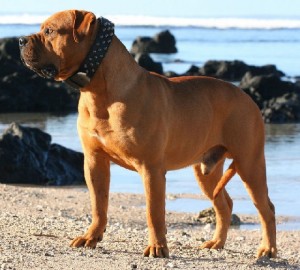- Home
- Contact Us
- Register
- ORKC Breeders
- About the ORKC
- Board of Directors
- ORKC Judges
- Breeds Set Standards
- Membership Benefits
- Certificate/Pedigree
- Register Litter
- Single Adult Register
- Single Puppy Register
- Register Kennel
- Register Kennel List
- Single Non Breeding Register
- Weight-pulling
- DNA Request
- Show Form
- Magazine/Newspaper
- 3 Generation
- 4 Generation
- 5 Generation
- Forms
- Link to Us
- ORKC Handicap Dog Register
- Online Store
Ca de Bou

Believed to had arrived to the Balearic Islands in the 1200’s, the Majorcan cattle dog Ca de Bou looked very different before the 1700’s, when the British introduced their bulldogs and mastiffs to the region. Originally, two types of the Ca de Bou existed, these being the bully and the shepherd varieties, but over the years the bully type became the favored one. Numerous crosses were made intended to create a superior bull-baiting and fighting dog, resulting in a somewhat standardized mastiff-type Ca de Bou which survived until the 1900’s, when the baiting sports started to lose their appeal and the breed became a farm dog and a property guardian.
By the time the breed was recognized in the 1960’s, there was only a handful of pure dogs to be found in Mallorca. A revival PROGRAM was started in the 1970’s, successfully increasing the number of these beautiful Majorca Bulldogs through a series of crosses between the pure and non-pure specimens, as well as controlled inbreeding.
The English Mastiff, Bullmastiff and even Rottweiler and American Bulldog are rumored to had been employed in some lines, but these claims haven’t been confirmed. The only outside breed that was “officially” used in the re-creation is the Ca de Bestiar, seeing how these two breeds have some common ancestry. However, since the bully type is the preferred one, not a lot of modern Ca de Bou examples reflect the Ca de Bestiar heritage.
Today, the Ca de Bou is becoming an increasingly popular breed, due to its friendly and playful personality. A loyal and lovely family dog, this is an immensely powerful breed, full of courage and drive, making it an excellent watchdog. The traces of its fighting past can still be found in its aggressiveness towards dogs, which is why proper socialization from an early age is crucial. Large-headed, wide-chested and strongly-boned, the Ca de Bou is a very handsome and impressive Molosser. While the cropping of ears and docking of tails was sometimes done in the past, modern dogs are left in their natural state.
The short coat is hard and smooth, preferably yellow, lion-golden or tan in color, but fawn, brown, brindle and black dogs aren’t uncommon. Black mask is preferred, although not obligatory. Even though black-n-tan and piebald dogs exist, they aren’t valued by the breed purists, but small white markings are acceptable. The average height is around 23 inches.
Other Names:
Ca de Bou, Mallorquin Mastiff, Mallorquin Bulldog, Perro Dogo Mallorquin (Spanish), Majorca Mastiff, Majorcan Bulldog,
Personality :
quite – loyal – extremely courageous – confident – protective
Size :
20 to 23 inches
Weight :
30 to 40kg (66 to 88 lb)
Coat :
Short, harsh, smooth, lying close to the skin.
Color :
Fawn, brindle, dark striped with white markings.
Life Span :
10 to 12 years.
Perro de Presa Mallorquin Breed Info
The Perro de Presa Mallorquin’s are quiet by nature. However, when needed they can be courageous and brave. These dogs are at ease with people, faithful and devoted to their master and natural guard dogs. The Perro de Presa Mallorquin was developed for power and tenacity, and these are strong components of its personality. If challenged, it will not back down, although it is respectful of all in the family including children. However, it is critical that it be properly socialized from puppy hood.
As a watch and guard dog, the Perro de Presa Mallorquin’s are unsurpassed. These dogs are extremely protective and when roused the expression of these dogs is piercing. Because of their power and protective nature these dogs require discipline and leadership. Weak owners would find this dog quite stubborn and dominating. This is an intelligent dog that needs an owner who is experianced and patient.
These dogs were initially bred to face up almost any challenge thrown. Harsh training or correcting methods will only provoke the Perro de Presa Mallorquin and could prove risky. Instead, owners should work with their Perro de Presa Mallorquin from puppy hood to train obedience and manners in as positive a way as possible but correcting any bad behavior from the start. Working with experienced trainers is critical. The Perro de Presa Mallorquin remains formidably powerful and alert, and retains the tenacity of its bull-baiting past.
Like many molosser breeds, the Perro de Presa Mallorquin is a very independent breed. Psychologically well-balanced, the Perro de Presa Mallorquin is laib-back and reserved in temperament and certainly not a ‘attention-seeker’. He can lay in the sun or at your feet for hours, but does not need more than a fraction of a second to resume his task as a guardian if needed. He is naturally distrustful of strangers and his strong sense of territoriality makes him an excellent guard dog.
Special Characteristics: The Airedale Terrier is feisty and easily aroused
Exercise Requirements: High. This is the largest of the terriers and needs plenty of exercise.
Perfect Owner: The Perro de Presa Mallorquin needs an owner who understands dogs natural “pack order”. Proper human to canine communication is essential. This breed is not for the casual pet owner. This breed is strong-minded but obedient if the owners are stronger minded than the dog. If they are not, they will find a dog that will test them every step of the way. Someone with a large backyard or access to safe open area will do good with this dog.
Nature Towards…
Owners :
Faithful and Devoted
Children:
They adore children. However it is critical that this dog is well socialized and trained from puppy hood
Other Pets:
Possible if raised together from start as well as well trained and socialized
Strangers:
naturally distrustful of strangers, however well trained dogs can be controlled well.
Unfamiliar
Dogs:
good if raised together but can be problemetic if not well trained or socialized from start.
Potential Problems
• Untained and unsocialzed dogs can become quite difficult to haldle and can be problematic for people visiting your house.
• Like all large dogs, they can develop skeletal problems if not provided with adequate nutrition and exercise from start.
• Untrained dogs can become agressive and difficult to hadle.
History
Since ancient times, seafaring from East to West in the Mediterranean region has led to the exchange of culture and science between nations. These reciprocal relations, even though mainly of a commercial nature, also gave the opportunity for an exchange of domestic animals.
Amongst these were watch and guard dogs which were needed in harbours and coastal settlements as a protection against pirates and robbers coming in by sea. Amongst these mostly large, strong, resistant dogs with large heads and powerful teeth, one type distinguished itself. It was the mastiff of the Iberian Peninsula, which, in Spain, was used in various areas as a hunting or as a fighting dog against bulls and other dogs. This breed accompanied King Jacob 1 on his conquests and arrived in the Balearics about the year 1230. In the 17th century, Minorca and others areas came into British possession, following the treaty of Utrecht.
The British brought their own fighting and guard dogs with them into the Balearics and crossed them with the native mastiffs of the Iberian Peninsula, which also occurred in the Balearic Isles. In the beginning of the 18th century, fights between dogs and bulls (bull baiting) were very popular and the Britons inhabiting the Island looked for a breed which would be held suited to such fights. These circumstances explain the name “Ca de Bou”, Bull Dog. In the Spanish Stud Book for the year 1923, the existence of this breed is already established.
The first official entry was in the year 1928 and in 1929, when such a breed was exhibited for the first time at a Dog Show in Barcelona.


